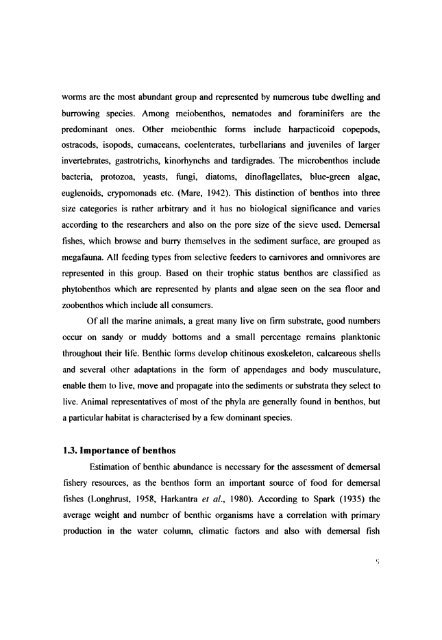L - Cochin University of Science and Technology
L - Cochin University of Science and Technology
L - Cochin University of Science and Technology
You also want an ePaper? Increase the reach of your titles
YUMPU automatically turns print PDFs into web optimized ePapers that Google loves.
wonns are the most abundant group <strong>and</strong> represented by numerous tube dwelling <strong>and</strong><br />
burrowing species. Among meiobenthos, nematodes <strong>and</strong> foraminifers are the<br />
predominant ones. Other meiobenthic t'onns include harpacticoid copepods,<br />
ostracods, isopods, cumaceans, coelenterates, turbellarians <strong>and</strong> juveniles <strong>of</strong> larger<br />
invertebrates, gastrotrichs, kinorhynchs <strong>and</strong> tardigrades. The microbenthos include<br />
bacteria, protozoa, yeasts, fungi, diatoms, din<strong>of</strong>lagellates, blue-green algae,<br />
euglenoids, crypomonads etc. (Mare, 1942). This distinction <strong>of</strong> benthos into three<br />
size categories is rather arbitrary <strong>and</strong> it has no biological significance <strong>and</strong> varies<br />
according to the researchers <strong>and</strong> also on the pore size <strong>of</strong> the sieve used. Demersal<br />
fishes, which browse <strong>and</strong> burry themselves in the sediment surface, are grouped as<br />
megafauna. All feeding types from selective feeders to carnivores <strong>and</strong> omnivores are<br />
represented in this group. Based on their trophic status benthos are classified as<br />
phytobenthos which are represented by plants <strong>and</strong> algae seen on the sea floor <strong>and</strong><br />
zoobenthos which include all consumers.<br />
Of all the marine animals, a great many live on finn substrate, good numbers<br />
occur on s<strong>and</strong>y or muddy bottoms <strong>and</strong> a small percentage remains planktonic<br />
throughout their life. Benthic f'onns develop chitinous exoskeleton, calcareous shells<br />
<strong>and</strong> several other adaptations in the fonn <strong>of</strong> appendages <strong>and</strong> body musculature,<br />
enable them to live, move <strong>and</strong> propagate into the sediments or substrata they select to<br />
live. Animal representatives <strong>of</strong> most <strong>of</strong> the phyla are generally found in benthos, but<br />
a particular habitat is characterised by a few dominant species.<br />
1.3. Importance <strong>of</strong> benthos<br />
Estimation <strong>of</strong> benthic abundance is necessary for the assessment <strong>of</strong> demersal<br />
fishery resources, as the benthos fonn an important source <strong>of</strong> food for demersal<br />
fishes (Longhrust, 1958, Harkantra et al., 1980). According to Spark (1935) the<br />
average weight <strong>and</strong> number <strong>of</strong> benthic organisms have a correlation with primary<br />
production in the water column, climatic factors <strong>and</strong> also with demersal fish

















